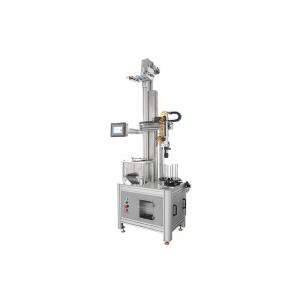Product Details
Lens Shock Impact Ability Lab Testing Machine With Graphic Users
Interface
Introduction:
Lens Shock Impact Ability Testing Machine will test the impact of lenses to meet the applicable ANSI,FDA and
European requirement. All the lenses must pass an impact test,
known as the "Drop Ball Test": a 16-millimeter steel ball is
dropped onto the lens from a height of 1.27 meter
Specification:
1) 5/8-inch steel ball weighing approximately 0.56 ounce
2)Dropped from a height of 50 inches upon the horizontal upper
surface of the lens.
3)The ball shall strike within a 5/8 inch diameter circle located
at the geometric center of the lens.
4)The ball may be guided but not restricted in its fall by being
dropped through a tube extending to within approximately 4 inches
of the lens.
5)To pass the test, the lens must not fracture
2)Drop ball System
Drop ball system includes pneumatic finger, lift synchronous belt,
cleaning brush, steel ball recycling and reputing system
3) Pneumatic finger
Pneumatic finger is used to clamp and release ball.
4) Lift synchronous belt
Lift synchronous belt delivers the pneumatic finger with steel ball
to requested drop height 1.27m.
5) Cleaning brush
Cleaning brush sweep the tested lenses to recycling box
6) Steel ball recycling and reputing System
Steel ball recycling and reputing system will sort out balls from
tested lenses and return to initial drop point, wait to be clamped
by cylinder finger. Reputing system will automatically supply new
steel ball to continue testing once balls can not be returned to
initial point.
7) PLC Controler
PLC controller and touch screen panel for easy operation system
What kinds of Lens should test?
1. Q. What are the impact testing requirements for prescription (Rx)
glass lenses?
A. The manufacturer must test each finished Rx glass lens
individually for impact resistance (21 CFR 801.410(c)(3)). The lens
must be capable of withstanding the impact test provided in 21 CFR
801.410(d)(2) as described later in this document under “Testing
Apparatus and Procedure.” You should perform testing after the lens
has been edged (cut to the shape of the frame) but before the lens
is put into the frame.
2.Q. What are the impact testing requirements for non-prescription
(over-the-counter) glass lenses, e.g., magnifying spectacles and
nonprescription sunglasses?
A. You must test a statistically significant sample of
over-the-counter glass lenses from each production batch. The
sample must be representative of the finished forms as worn by the
wearer, including forms that are of minimal lens thickness and have
been subjected to any treatment used to impart impact resistance.
Image:
Company Profile
Haida established in 2004 in Dongguan City, where is the “silicon
valley” of world manufacturing industry. It is a certified national
high-tech enterprise engaged in design, research and development,
production, sales, calibration and after-sale service of test
equipment, such as paper&packaging test equipment, Furniture
test equipment, material mechanics test equipment, optical
measurement equipment, environmental reliability testing equipment
etc. With the persistent efforts of all staff, Haida owned 4
factories with total 60,000 square meters, 15 branch offices covers
South China, North China, East China, Central China and Northwest
China, as well over 20 overseas after-sales service sites covers
Southeast Asia, Europe, North America and the Middle East with over
28,000 customers.


Haida main business scope includes equipment production, non-standard
equipment customization, software development, measurement and
maintenance consulting services. The company has passed ISO9000
certification and multiple certifications by internationally
renowned testing organizations such as BV, SGS, TUV, and its
products comply with GB, ISO, ASTM, EN, JIS, TAPPI, ISTA, DIN, BS
and other domestic and foreign standards. Meanwhile, invested a
large amount of research and development funds to adhere to the
product concept of R & D , sales and products reserve to walk
at the forefront of the industry. Moreover Haida participated in
composing of furniture test standards and commonly drew up
CY/T229-2020 industry standards with the National quality
inspection, jointly developed industry test equipment with the
National Paper Products Center and Dongguan Quality Testing
Furniture Laboratory, co-built the reliability laboratory with many
well-known enterprises, and Jointly built the dangerous articles
packaging laboratory with Guangdong Huangpu Customs Technology
Center.

Haida adheres to the vision of "To be the World Class Testing Equipment
enterprise" and attaches importance to platform construction and
talent reserves. Having 630 employee which contain 150 technicians
and more than 300 bachelors, 5 Masters, and 3 PhDs. Haida have won
2 national invention patents and over 100 utility model patents, At
the same time, established 5 industry-university-research
cooperation bases with universities and research institutes and
invited more than 20 doctoral supervisors as consultants.


Looking forward to the future, Haida will fulfill the mission of
"Deliver the best testing equipment to our customers" and adhere to
the core values of "Creative, Efficiency, Inheritance, Passion and
Persistence". Taking a green, low-carbon, and environmentally
friendly sustainable development path, Haida will continuously
optimize the product structure to realize the transformation and
upgrade of the enterprise itself. It is the eternal pursuit of
Haida people to build Haida into a comprehensive provider of
testing equipment with advanced technology, excellent quality,
high-quality service, and win-win cooperation!




